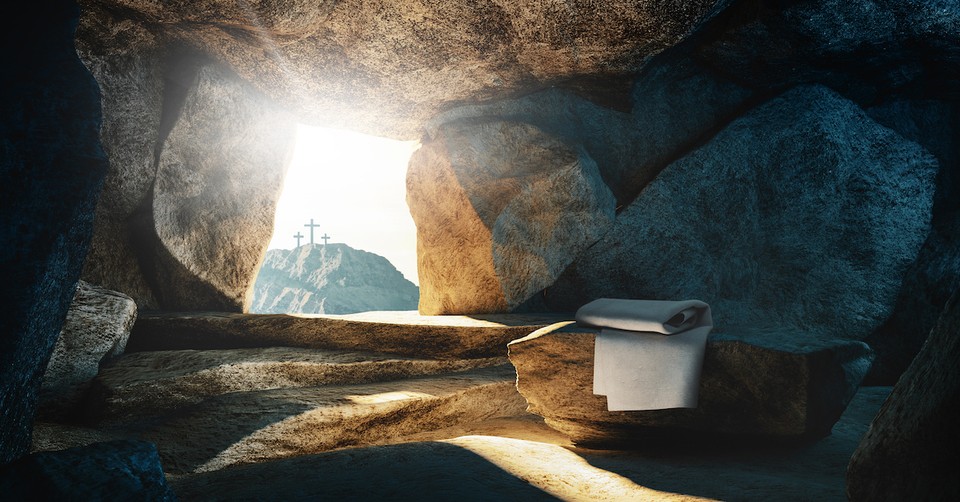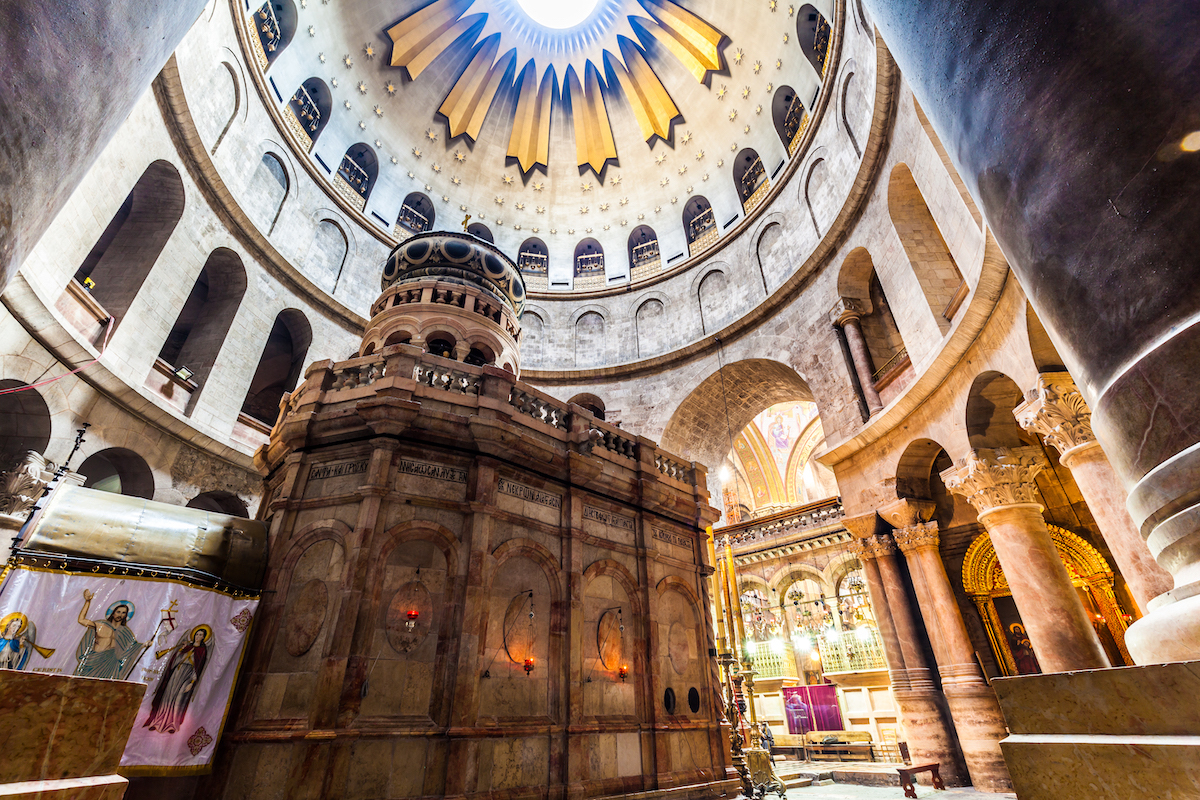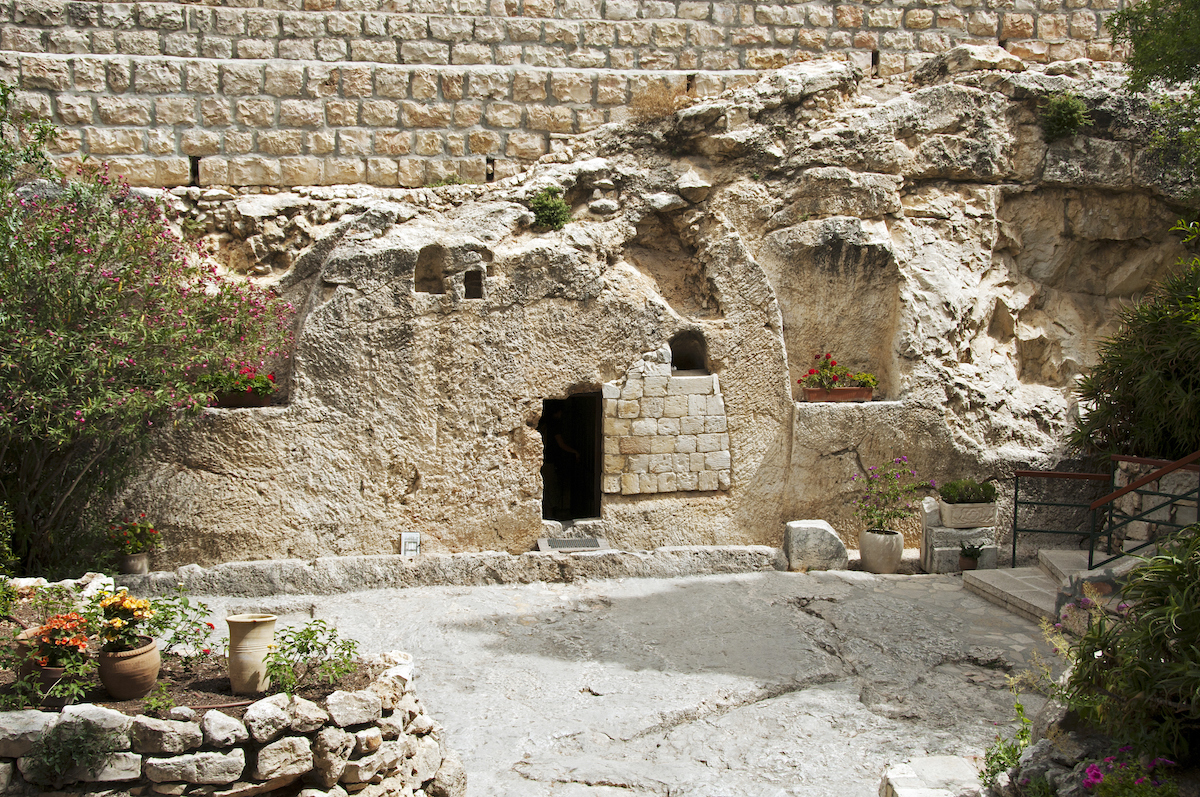Where Was Jesus Buried and Why is His Tomb so Crucial to Christianity?

One of the least talked about elements of the Easter story is Jesus’ tomb. After all, he left that burial place on Easter Sunday when he conquered death. So why dwell on his burial when he had overcome the grave? In fact, the disciples didn’t seem to pay the burial place of Jesus any mind during their ministry, which is why, archeologists still haven’t reached a consensus on the correct place for the tomb in which Jesus’ body was placed until that fateful Sunday.
In this article, we’ll explore some of the possible places of Jesus’ burial, including possible locations of Jesus' tomb that accept visitors. We’ll also talk about why the tomb is one of the most single important parts of our foundation of our Christian beliefs. Let’s dive in.
Get your FREE Holy Week Guide here. Have encouragement delivered straight to your inbox!
What Does the Bible Say about Jesus’ Tomb and What Did It Look Like?
According to biblical descriptions, particularly from the New Testament Gospels, Jesus' tomb was a rock-hewn tomb, new and unused, located near the place of His crucifixion, which was outside the city walls of Jerusalem. It was owned by Joseph of Arimathea, a wealthy man and a member of the Jewish council, who provided his own tomb for Jesus' burial. The tomb entrance was sealed with a large stone rolled across it. Inside, it was spacious enough to allow at least a few individuals to enter, as described in the accounts of the women and disciples visiting the tomb after Jesus' resurrection. This setting reflects the burial practices of wealthy Jews of the time, who often used garden tombs cut from rock for their dead.
All four Gospel accounts have something to say about Jesus’ tomb. Let’s dissect each of them.
Matthew 27:57-61: “Now when evening had come, there came a rich man from Arimathea, named Joseph, who himself had also become a disciple of Jesus. This man went to Pilate and asked for the body of Jesus. Then Pilate commanded the body to be given to him. When Joseph had taken the body, he wrapped it in a clean linen cloth, and laid it in his new tomb which he had hewn out of the rock; and he rolled a large stone against the door of the tomb, and departed. And Mary Magdalene was there, and the other Mary, sitting opposite the tomb.”
Jesus gets an odd burial for a person crucified at Golgotha. Most criminals executed there did not receive a burial, let alone in the tomb of a rich man. Jesus receives proper burial rites, which included using oils to embalm the body and wrapping it in cloth, like a mummification process. Myrrh was perhaps amongst one of these oils to delay the decomposition of the body, one of the gifts of the Magi given to Jesus.
The women who followed Jesus make note of his burial spot (there was likely several tombs in the area).
Mark 15:42-47: “It was Preparation Day (that is, the day before the Sabbath). So as evening approached, Joseph of Arimathea, a prominent member of the Council, who was himself waiting for the kingdom of God, went boldly to Pilate and asked for Jesus’ body. Pilate was surprised to hear that he was already dead. Summoning the centurion, he asked him if Jesus had already died. When he learned from the centurion that it was so, he gave the body to Joseph. So Joseph bought some linen cloth, took down the body, wrapped it in the linen, and placed it in a tomb cut out of rock. Then he rolled a stone against the entrance of the tomb. Mary Magdalene and Mary the mother of Joseph saw where he was laid.”
We need to make two important notes here. First, they had to bury Jesus before Saturday (Sabbath day). Because touching dead body would’ve been unclean, and in lieu of the Passover festival, they would’ve been working on a Saturday, a no-no in that culture.
Secondly, they roll a stone against the tomb. This thing weighs tons. So even if Jesus swooned on the cross (which he did not) instead of died, he would’ve suffocated in the tomb, rather than having the ability simply to roll this massive thing out of the way. Especially in his tortured state.
Luke 24:1-8: “On the first day of the week, very early in the morning, the women took the spices they had prepared and went to the tomb. They found the stone rolled away from the tomb, but when they entered, they did not find the body of the Lord Jesus. While they were wondering about this, suddenly two men in clothes that gleamed like lightning stood beside them. In their fright the women bowed down with their faces to the ground, but the men said to them, “Why do you look for the living among the dead? He is not here; he has risen! Remember how he told you, while he was still with you in Galilee: ‘The Son of Man must be delivered over to the hands of sinners, be crucified and on the third day be raised again.’” Then they remembered his words.”
The Gospel accounts show angels at the tomb on that fateful Easter day. Others talk about how guards had been placed at the tomb (probably to prevent people from stealing the body). But the guards flee when an earthquake jostles the tomb. We need to keep in mind, these guards could’ve lost their lives for abandoning their posts. They would’ve taken the job seriously, and not fallen asleep at it—las some people have suggested.
John 20:3-7: “So Peter and the other disciple started for the tomb. Both were running, but the other disciple outran Peter and reached the tomb first. He bent over and looked in at the strips of linen lying there but did not go in.Then Simon Peter came along behind him and went straight into the tomb. He saw the strips of linen lying there, as well as the cloth that had been wrapped around Jesus’ head. The cloth was still lying in its place, separate from the linen.”
When Jesus leaves the tomb, after rolling away the stone, he leaves behind his burial cloths. Some have suggested that the Shroud of Turin was the exact linens in which they buried Jesus. It’s also important to note that if someone had tried to rob Jesus from the tomb they would not have taken the time to fold Jesus’ funeral linens all nicely and wrapped him up in something else. They wouldn’t have had the time with the Roman guards outside. Plus, the Roman guards would’ve caught them and killed them.
Where Is Jesus' Tomb Located?
Archaeological findings and historical evidence related to Jesus' burial site primarily focus on two locations: the Church of the Holy Sepulchre in Jerusalem and the Garden Tomb outside the city walls.
The most famous is the Church of the Holy Sepulchre, where you can visit a tomb that matches the description found in the Bible. Church of the Holy Sepulchre is widely regarded by many Christian denominations as the site where Jesus was crucified, buried, and resurrected. Established by Constantine the Great in the 4th century after his mother, Helena, identified the location, the church has undergone numerous reconstructions due to damage from fires, earthquakes, and invasions over centuries.It houses both Golgotha (the site of the crucifixion) and what is believed to be Jesus' tomb. This church, located in Jerusalem, is traditionally considered the site of both Jesus' crucifixion and burial.

Photo credit: iStock/Getty Images/LUKASZ-NOWAK1 - JERUSALEM, ISRAEL - CIRCA MAY 2018: Church of the Holy Sepulchre circa May 2018 in Jerusalem.
The Garden Tomb, located just outside Jerusalem's city walls, was an alternative proposed site for the burial and resurrection of Jesus Christ in the 19th century. This location was identified in the 19th century by General Charles Gordon, who believed it more closely matched the biblical description of Jesus' tomb rather than the traditional site at the Church of the Holy Sepulchre. The Garden Tomb is characterized by its rock-hewn tomb set within a tranquil garden setting, fitting the Gospel accounts of Jesus' burial place being near a garden. It has since become a popular site for visitors and pilgrims who appreciate its peaceful ambiance and its significance as a potential site of one of Christianity's most sacred events.
Unlike the Church of the Holy Sepulchre, the Garden Tomb offers a more contemplative atmosphere, encouraging reflection and prayer. Though it lacks the historical and ecclesiastical tradition of the Holy Sepulchre, many find its simplicity and setting to be spiritually meaningful.

photo credit: iStock/Getty Images/compuinfoto - The Garden Tomb, place of the resurrection of Jesus Christ in Jerusalem Israel
Each site has been subject to archaeological scrutiny, but definitive proof remains elusive due to the ancient nature of the events and the transformations these sites have undergone over millennia.There are some possible locations that have been suggested for where Jesus was buried.
Who Visited Where Jesus Was Buried?
According to the detailed accounts in the New Testament Gospels, a number of individuals made significant visits to Jesus' burial site following His crucifixion, each encounter marked by its own unique revelations and responses to the profound mystery of His resurrection.
Mary Magdalene and the other Mary: As recorded in Matthew 28:1, these two faithful followers of Jesus went to see the tomb at dawn on the first day of the week. Their visit was marked by an extraordinary event: an angel of the Lord descended from heaven, rolled back the stone, and sat on it, announcing to them that Jesus had risen from the dead.
Women from Galilee: Luke's Gospel (24:1-10) expands the narrative to include a group of women, among them Mary Magdalene, Joanna, and Mary the mother of James, who came to the tomb carrying spices to anoint Jesus' body. Instead of finding His body, they encountered two men in dazzling clothes who told them that Jesus was not there but had risen.
Peter and John: Triggered by Mary Magdalene's report of the empty tomb, Peter and John ran to the tomb to see for themselves, as detailed in John 20:1-8. John arrived first but waited outside, allowing Peter to enter the tomb first where he observed the linen cloths lying by themselves. John then entered, saw the same evidence, and believed in the resurrection, even though he did not fully understand it at that time.
Mary Magdalene (alone): After Peter and John left, Mary Magdalene stood weeping outside the tomb. It was then, as recounted in John 20:11-18, that she had a personal encounter with the risen Jesus, initially mistaking Him for the gardener until He called her by name. This poignant moment transformed her grief into a profound joy, making her the first to witness and testify to the resurrection.
Why Does Jesus' Tomb Matter So Much?
Why does the tomb matter so much? Because if Jesus had not been raised from the dead, if the disciples just spread a lie, the Roman officials could have simply taken people to the burial place of Jesus and said, “Look, his body is right there.” But they didn’t. In fact, Scripture provides rumors the Romans attempted to spread because they had not good explanation for why the body disappeared (Matthew 28:13).
Jesus did not swoon, and the disciples did not steal the body. Jesus would have suffocated by the time he could’ve opened the tomb. And besides, water poured out of him on the cross when pierced, a surefire sign of death (John 19:34). The disciples fled from the Garden of Gethsemane. They didn’t have the gumption to suddenly steal Jesus’ body from the tomb right under the noses of some very alert Roman guards.
And for what? To endure execution and torture all in the name of a lie?
No. The tomb shows us that Jesus resurrected. Because Jesus no longer lies in the tomb, we have a hope that is foundational to our beliefs. Because Jesus left the tomb, we can have a chance to experience eternal life with him.
Photo credit: ©GettyImages/alessandrophoto
Hope Bolinger is an acquisitions editor at End Game Press, book editor for hire, and the author of almost 30 books. More than 1500 of her works have been featured in various publications. Check out her books at hopebolinger.com for clean books in most genres, great for adults and kids. Check out her editing profile at Reedsy.com to find out about hiring her for your next book project.
This article is part of our larger Holy Week and Easter resource library centered around the events leading up to the death and resurrection of Jesus Christ. We hope these articles help you understand the meaning and story behind important Christian holidays and dates and encourage you as you take time to reflect on all that God has done for us through his son Jesus Christ!
What is Lent? It's Meaning and Why We Celebrate
When is Lent? When Does Lent Start and End?
What is the Meaning Ash Wednesday?
What is Holy Week?
What Is the Meaning of Palm Sunday?
What is the Meaning of Holy Monday?
What is Maundy Thursday?
What Is Good Friday and Why is it Good?
Good Friday Prayer
What Does Holy Saturday Mean?
What Is the Easter?
Easter Prayers
Powerful Facts About the Cross of Jesus
Originally published February 15, 2024.







